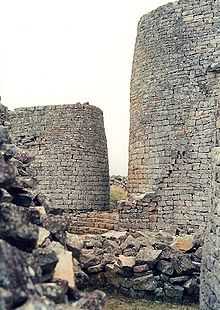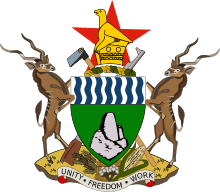Kingdom of Zimbabwe
| Kingdom of Zimbabwe | |||||
| Zimbabwe | |||||
| Kingdom | |||||
| |||||
| Capital | Great Zimbabwe | ||||
| Religion | Belief in Mwari | ||||
| Government | Monarchy | ||||
| Mambo | Rusvingo (first) | ||||
| Unknown (last) | |||||
| History | |||||
| - | Abandonment of Mapungubwe for Zimbabwe | 1220 | |||
| - | Zimbabwe conquest of Mutapa | 1430 | |||
| - | Abandonment of Zimbabwe for Mutapa | 1450 | |||
The Kingdom of Zimbabwe (1220–1450) was a kingdom located in the territory of modern-day Zimbabwe. It is famous for its capital, Great Zimbabwe, the largest stone structure in southern Africa until recent times.
Name
Zimbabwe is the modern name issued to the most prominent pre-colonial civilisation in southern Africa. The name is derived from one of two possible terms: the Shona (dzimba dza mabwe or "great stone houses") or Kalanga (Nzi we mabwe or "Homestead of Stone").
Origin
The creators of the Zimbabwe kingdom immigrated to the Zimbabwe plateau from the Kingdom of Mapungubwe in southern Africa in the early 13th century.
Culture and expansion

The rulers of Zimbabwe brought artistic and stonemasonry traditions from Mapungubwe. The construction of elaborate stone buildings and walls reached its apex in the kingdom. The institution of mambo was also used at Zimbabwe, along with an increasingly rigid three-tiered class structure. The kingdom taxed other rulers throughout the region. The kingdom was composed of over 150 tributaries headquartered in their own minor zimbabwes.[1] They established rule over a wider area than the Mapungubwe, the Butua or the Mutapa.
Economy
The Kingdom of Zimbabwe controlled the ivory and gold trade from the interior to the southeastern coast of Africa. Asian and Arabic goods could be found in abundance in the kingdom. Economic domestication, which had been crucial to the earlier proto-Shona states, was also practised. The Great Zimbabwe people mined minerals like gold, copper and iron. They also kept livestock, as it is explained by its theory of cattle hypothesis.
Mutapa Conquest and Decline
In approximately 1430, a prince from the Great Zimbabwe traveled north to the Dande region in search of salt. He[Nyatsimba Mutota] then defeated the Tonga and Tavara with his army and established his dynasty at Chitakochangonya Hill. The land he conquered would become the Kingdom of Mutapa. Within a generation, Mutapa eclipsed Zimbabwe as the economic and political power in Zimbabwe. By 1450, the capital and most of the kingdom had been abandoned.
Aftermath
The end of the kingdom resulted in a fragmenting of proto-Shona power. Two bases emerged along a north-south axis. In the north, the Kingdom of Mutapa carried on and even improved upon Zimbabwe's administrative structure. It did not carry on the stone-masonry tradition to the extent of its predecessor. In the south, the Kingdom of Butua was established as a smaller, but nearly identical, version of Zimbabwe. Both states were eventually absorbed into the largest and most powerful of the Kalanga states, the Rozwi Empire.
See also
- Great Zimbabwe
- Kingdom of Mapungubwe
- History of Zimbabwe
- Kingdom of Butua
- Kingdom of Mutapa
- Khami Ruins
- Dlodlo Ruins
References
- ↑ Owomoyela, page 7
Sources
- Oliver, Roland & Anthony Atmore (1975). Medieval Africa 1250–1800. Cambridge: Cambridge University Press. p. 738. ISBN 0-521-20413-5.
- Owomoyela, Oyekan (2002). Culture and customs of Zimbabwe. Westport: Greenwood Publishing Group. p. 163. ISBN 0-313-31583-3.
- Stewart, John (1989). African States and Rulers. Jefferson: McFarland & Company, Inc. p. 395. ISBN 0-89950-390-X.
- Wieschhoff, H. A. (2006). The Zimbabwe-Monomotapa Culture in Southeast Africa. Whitefish: Kessinger Publishing. p. 116. ISBN 1-4286-5488-7.
Part of a series on the |
||||||||||||||||||||||||||||||||||||||||
|---|---|---|---|---|---|---|---|---|---|---|---|---|---|---|---|---|---|---|---|---|---|---|---|---|---|---|---|---|---|---|---|---|---|---|---|---|---|---|---|---|
| History of Zimbabwe | ||||||||||||||||||||||||||||||||||||||||
 | ||||||||||||||||||||||||||||||||||||||||
|
||||||||||||||||||||||||||||||||||||||||
|
||||||||||||||||||||||||||||||||||||||||
| Zimbabwe portal | ||||||||||||||||||||||||||||||||||||||||
